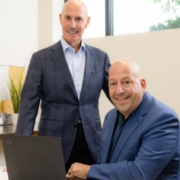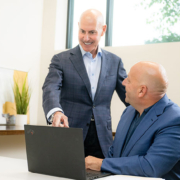Introducing the Phoenix3 Holdings Team
I have been fortunate in assembling a team of top in class executives and experts with a wide range of skill sets. I plan to introduce you to each of our team members and talk more about our portfolio in the coming weeks here in the Founder’s Mindset. Our first introduction this week is a big one…
It brings me great pleasure to announce Joe Cuticelli as Partner and Chief Operating Officer of Phoenix3 Holdings. Joe is an incisive decision-maker with rich leadership experience from helming one of the world’s largest employers through multiple phases of rapid growth.
Joe’s skillset is broad and his knowledge pool is incredibly deep. He is as committed and passionate as I am to building successful businesses that operate with integrity and that transform the lives of individuals and the communities they serve.
“We met as rivals and competitors years ago – he’ll tell you a little more about that in his own words below – and today, I’m gratified to have him join us as a leader at Phoenix3 Holdings.”
Joe Cuticelli, Partner and Chief Operating Officer
Officer
Joe Cuticelli is a highly accomplished executive, with a dynamic history of leadership at Sodexo North America where he held progressively demanding leadership roles, ultimately serving as its CEO of senior living. He is a navigator of complex organizational structures and global markets with an incisive intuition for how to scale strategically and successfully.
During his tenure at Sodexo, Joe exceeded sales and financial targets at every level, developing a wide-ranging and sharp skill set across business development, sales, and operations management. After stepping down from Sodexo, Joe founded Marleon Capital, leveraging his deep industry knowledge to provide invaluable business expertise to companies within the insurance restoration industries.
Joe is intensely passionate about making a positive impact in people’s lives. Aside from his advisory role in the corporate world, he also serves as the Board Chairman for Generations United, an organization that enhances the lives of children, youth, and elders through intergenerational collaboration and public policy.

Q&A: Get to Know Joe
How did you and Richard meet?
We were competitors. In the span of my career, Unidine and later CCL was always a competitor. What’s interesting is I didn’t know much about Richard, but I had a great admiration for Unidine, the way they presented themselves along with the platform and values that they put forward in the marketplace.
As a competitor, they were successful, and they were growing fast. It was a startup that was taking a segment of the market that we were all interested in, but they seemed to do it with a lot more rigor and discipline than we were.
I remember going to a sales meeting and we presented first. Afterwards we thought, “We did a great job.” Then we walked outside and there’s a giant box truck parked against the building – and out comes Unidine, off-loading their sales presentation. We were shoving our stuff in cars. We were nowhere near what they were doing to present their business case, and I thought to myself, they always seem one step ahead.
Later on in my career when I became CEO, Richard and I would collaborate with each other at different industry events. And while we were competitors, we were very respectful of one another and always found time to speak with one another. Doing so we developed a mutual recognition and admiration for the other’s skills.
How did you approach your role as a CEO and leader managing expansion at a global company with such a huge array of service offerings?
I had to approach it with an open-mind that I was going to learn a lot. At one point we would tell people we had 100 different services that we could provide. We had some core things that we did – food, facilities, management – but within that, we were doing transportation, energy, infrastructure management, to name a few. As a large company, we thought we could do it all.
There were times when my team came to me and said, “Can we do this?”, and while it might have been in the scope of services that we provided, I knew we couldn’t do it well, and we had to be very disciplined about the delivery of our services – we want to be the best at the things that we can do.
Ultimately, we may not be able to do all things because we don’t have the resources, or it may be geographically challenged. One of the things about being a good leader is also knowing when to say no.
As a leader I needed to assess how quickly I could learn about those things that I didn’t know about within the business, measure the risks in how we deployed our services, and decide if it was appropriate for the business at that time.

What excites you about partnering at Phoenix3 Holdings?
I think there’s an opportunity to help companies grow in a space that we understand very well, whether that’s pure hospitality, senior living, healthcare, or corporate.
We understand this space really well and are looking for businesses that have a lot of white space and can scale very quickly. With Phoenix3 as a partner they can do that using the multiple years of expertise that we have in managing businesses.
It’s exciting to help others, to be successful and grow their business. I’m excited about the lives that we can impact by our mentorship, our knowledge and our association with these types of businesses. I think it’s a great opportunity.


